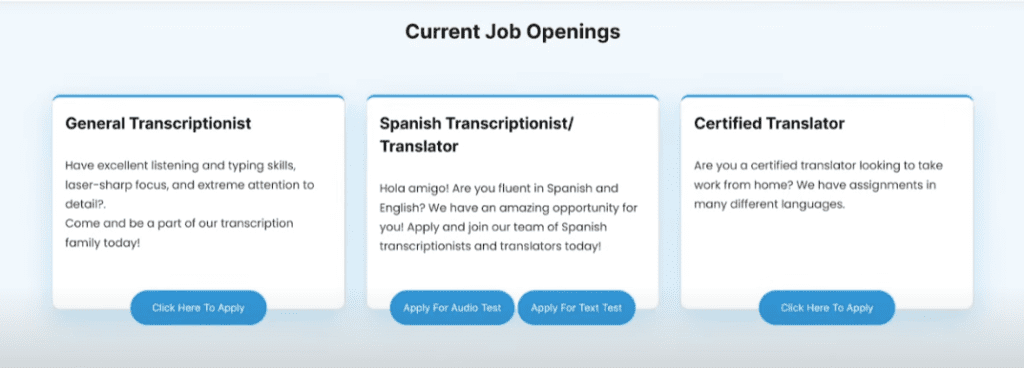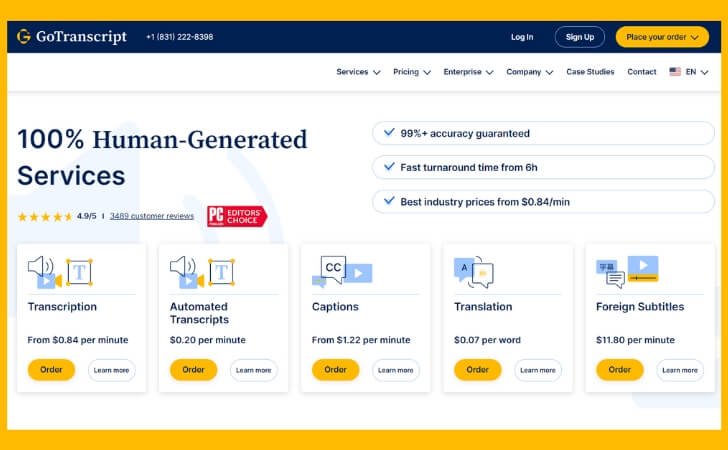AFFILIATE DISCLOSURE
This post may contain affiliate links. An affiliate means Escribr may earn referral fees if you make a purchase through our link without any extra cost to you. It helps to keep this blog afloat. Thanks for your support!
Did you know that by visiting this blog, you are doing good in the world? READ THIS.
Let’s talk about one of the big players in this industry: GMR Transcription.
People visit GMR Transcription to get their documents transcribed.
GMR Transcription isn’t just some run-of-the-mill transcription service. We’re talking about a company that’s earned the trust of big names like Harvard University and Amazon.
GMR Transcription isn’t just some run-of-the-mill transcription service.
We’re talking about a company that’s earned the trust of big names like Harvard University and Amazon.
Why Choose GMR Transcription Over AI?
In today’s world, many might wonder, “Why pay for transcription services when AI tools are available?”
The answer is simple: AI still can’t match the accuracy and quality of human transcription, especially for complex content.
That’s why companies continue to rely on human transcribers.
Earning Potential with GMR Transcription
How much can you actually earn as a transcriptionist with GMR?
GMR Transcription is known for offering competitive pay rates, allowing transcribers to earn anywhere between $1,000 to $3,000 per month.
This earning potential makes it a viable option for those looking to either supplement their income or pursue transcription as a full-time job.
Earning Potential Breakdown
Your exact earnings depend on several factors, including:
1. The number of projects you complete – GMR assigns projects based on availability and the quality of your previous work. The more reliable and accurate you are, the more likely you are to receive a steady stream of projects.
2. Your transcription speed – The faster and more accurately you can transcribe, the more projects you can complete. Some experienced transcribers can finish assignments quickly and, as a result, handle a larger volume of work.
3. The complexity of the content – Simple transcription projects may pay less, while more complex tasks—such as medical or legal transcription—can command higher rates. Specialized fields often require additional skills but reward transcribers with higher pay.
GMR offers opportunities in two main transcription categories:
1. General Transcriptionist (English) – If you have strong English skills, you can apply for this role.
It involves converting audio and video files into written text for a variety of industries, including business, education, entertainment, and more.
Depending on your skill level and the complexity of the projects, you can earn a decent income as an English transcriptionist.
Many English-speaking transcribers rely on GMR as their primary source of transcription work due to the consistency of projects available.

2. Spanish Transcriptionist – If you’re fluent in Spanish, GMR offers a valuable opportunity to transcribe Spanish audio and video files.
Spanish transcriptionists are in high demand, especially as companies seek to reach broader, multilingual audiences.
Because Spanish is one of the most spoken languages worldwide, being bilingual opens up more transcription jobs, increasing your earning potential.
Spanish transcription projects may vary in complexity, from translating and transcribing corporate meetings to working on academic research or entertainment content.
Benefits of Being Bilingual
If you’re bilingual in both English and Spanish, you have the advantage of applying for transcription jobs in both categories.
This could potentially double your workload and significantly increase your monthly income.
You can seamlessly switch between English and Spanish transcription projects, giving you access to a wider variety of assignments.
Many bilingual transcribers report that the flexibility of working in two languages allows them to maximize their income potential without sacrificing quality or overloading their schedules.
Exploring Other Transcription Opportunities
In addition to general and Spanish transcription roles, GMR occasionally offers more specialized opportunities.
For example, if you have experience in medical or legal transcription, you might be able to find higher-paying assignments in those fields.
These types of transcription often require a deeper understanding of terminology and industry-specific guidelines, but the compensation is generally higher due to the specialized knowledge required.
Transcribers with niche skills, such as the ability to transcribe foreign languages, are also in demand.
GMR’s clientele includes businesses and organizations from around the world, meaning there are occasionally projects requiring proficiency in languages other than English and Spanish.
If you possess such skills, it’s worth keeping an eye on these opportunities, as they can lead to higher pay and more diverse work.
Scammer Alert: Protecting Yourself
In this digital age, where opportunities abound, so do the scammers. And unfortunately, they’ve set their sights on the transcription industry.
GMR has issued a warning about some shady characters posing as recruiters on platforms like Upwork.

These people ask applicants for money, promising them a spot on the GMR team.
This is NOT how GMR operates.
GMR Transcription recruitment is done through job boards and forums such as FlexJobs, Transcription Essentials, the Transcription Certification Institute, and Wahm.com.
Interested candidates are encouraged to upload their resumes on these platforms, as GMR may reach out if there is interest in working together.
The real application process involves taking a test to be considered.
Applying to GMR Transcription
Transcription isn’t a get-rich-quick scheme.
It’s not like those ads you see promising you’ll make thousands while lounging on a beach sipping piña coladas.
This is real work that requires real skills and real dedication.

You’ll need to meet strict deadlines and your grammar needs to be on point.
We’re talking Oxford comma debates, semicolon mastery, and the ability to spot a dangling modifier from a mile away.
GMR is looking for people who can commit to at least 10 hours per week.
That might not sound like much, but when you’re transcribing, time can fly by faster than you’d think.
You need to be sure you can consistently dedicate this time to your transcription work.
To qualify, you need to type at least 50 words per minute with 90% accuracy or better.
Now, if you’re feeling a bit rusty, don’t worry.
Sites like typingtest.com are great for honing your skills.
Spend some time there, get your typing speed up, and watch that accuracy soar.
Before you know it, you’ll be ready to ace that test.
If you’re in the US, then you can apply by filling out the form on their website.

Wrap-Up
Remember, success in transcription isn’t just about typing fast (although that certainly helps).
It’s about attention to detail, a love for language, and the ability to truly listen.
It’s about transforming spoken words into clear, accurate written documents that capture not just the words, but the meaning behind them.
Is it challenging? Absolutely.
Will there be times when you’re puzzling over a muffled word or racing to meet a deadline? You bet.
But for many people, the flexibility, the constant learning, and the satisfaction of producing high-quality work make it all worthwhile.
With platforms like GMR Transcription and others, the opportunities are out there.
All you need is a computer, a good set of headphones, and the willingness to turn those typing skills into cold, hard cash.
Who knows? You might just find that transcription isn’t just a job but a calling, a chance to be part of preserving conversations, spreading knowledge, and making information accessible to all.











